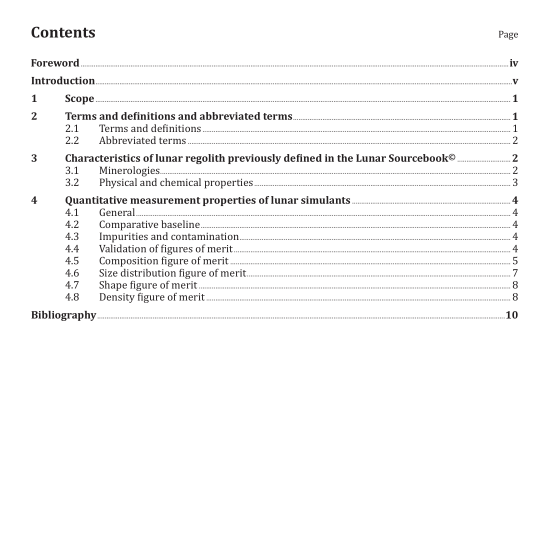BS ISO 10788:2014 pdf download.Space systems — Lunar simulants
3.2 Physical and chemical properties
3.2.1 General
Reference [3] provided a compilation of properties from Apollo and Lunakhod lunar samples of use to the scientific community. These properties are listed since a large amount of data exists for lunar regolith characterization using these properties. As demanded by scientific definitions, these properties are qualitative and quantitative. This means some properties can be measured directly while others are descriptive and are not readily measurable. While these properties are of value to planetary or lunar scientists, they do not address the needs of lunar systems developers and operators with a specific quantitative measure for lunar regolith simulants in comparison to other simulants and with relation to sampled lunar materials.
3.2.2 Physical properties
3.2.2.1 Geotechnical properties
a) particle size distribution;
b) particle shapes;
c) specific gravity;
d) bulk density;
e) porosity;
f) relative density;
g) compressibility;
h) shear strength;
i) permeability and diffusivity;
j) bearing capability;
k) slope stability;
l) trafficability.
3.2.2.2 Electrical and electromagnetic properties
a) electrical conductivity;
b) photoconductivity;
c) electrostatic charging;
d) dielectric permittivity.
3.2.3 Chemical properties
a) major elements;
b) incompatible trace elements;
c) miscellaneous minor elements;
d) siderophile elements;
e) vapor-mobilized elements;
f) solar wind implanted elements.
4 Quantitative measurement properties of lunar simulants
4.1 General
Lunar simulants can be measured as lunar samples were measured and published using 22 listed properties (see Clause 3).
However, the quality of lunar simulants measured in this way cannot be readily compared to lunar source material nor communicated across development and operational communities. Comparison of these measures for simulants for other than scientific purposes is not recommended. The more useful qualification of lunar simulants is tied to lunar minerologies and is expressed most concisely in four figures of merit: composition, size, shape, and density.
The figures of merit for lunar simulants range from zero to one. A figure of merit value of zero indicates no useful correlation to a comparative sample. A figure of merit value of one indicates exact correlation as defined by the standard measurements to a comparative sample.
A specific quantitative measure for lunar regolith simulants is made only in comparison to other simulants or with relation to sampled lunar materials from Apollo and Lunakhod missions. Data from existing lunar samples are necessary to use these figures of merit to establish a real baseline from the lunar surface.
4.2 Comparative baseline Comparative (quantitative) measures shall be stated for lunar simulants. Figures of merit for a simulant shall be stated against a single baseline. If multiple baselines are referenced for a simulant, a complete set of figures of merit shall be calculated for each reference.
4.3 Impurities and contamination Simulants can not be completely defined by these figures of merit for reasons of mineralogical impurity and contamination of the simulant by organic/inorganic materials. Impurity of the sample/simulant measured shall be stated in percent of the sample mass. Contamination of the sample/simulant shall be stated in percentage of the sample volume. Characterization of the sample contamination and the nature of that contamination shall be stated if an analysis is performed.
4.4 Validation of figures of merit Calculation of figures of merit for a simulant shall be performed and recorded for each use.
In the event a volume of simulant is re-used, the figures of merit shall be recalculated in accordance with this standard. Scaling (normalization) forces the norm of the difference of two composition vectors to lie between 0 and 1, and subtraction from unity results in a figure of merit of 1 for a perfect match and 0 for not match at all.
4.5 Composition figure of merit
4.5.1 Composition figure of merit formula
For example, in the constituent example table below, normalized concentrations for basalt are given for both the sample and the simulant (approximately 0,015 and 0,120, respectively). In the difference table,it is further shown that the basalt difference is 0,105 with a higher concentration in the simulant.BS ISO 10788 pdf download.BS ISO 10788 pdf download
